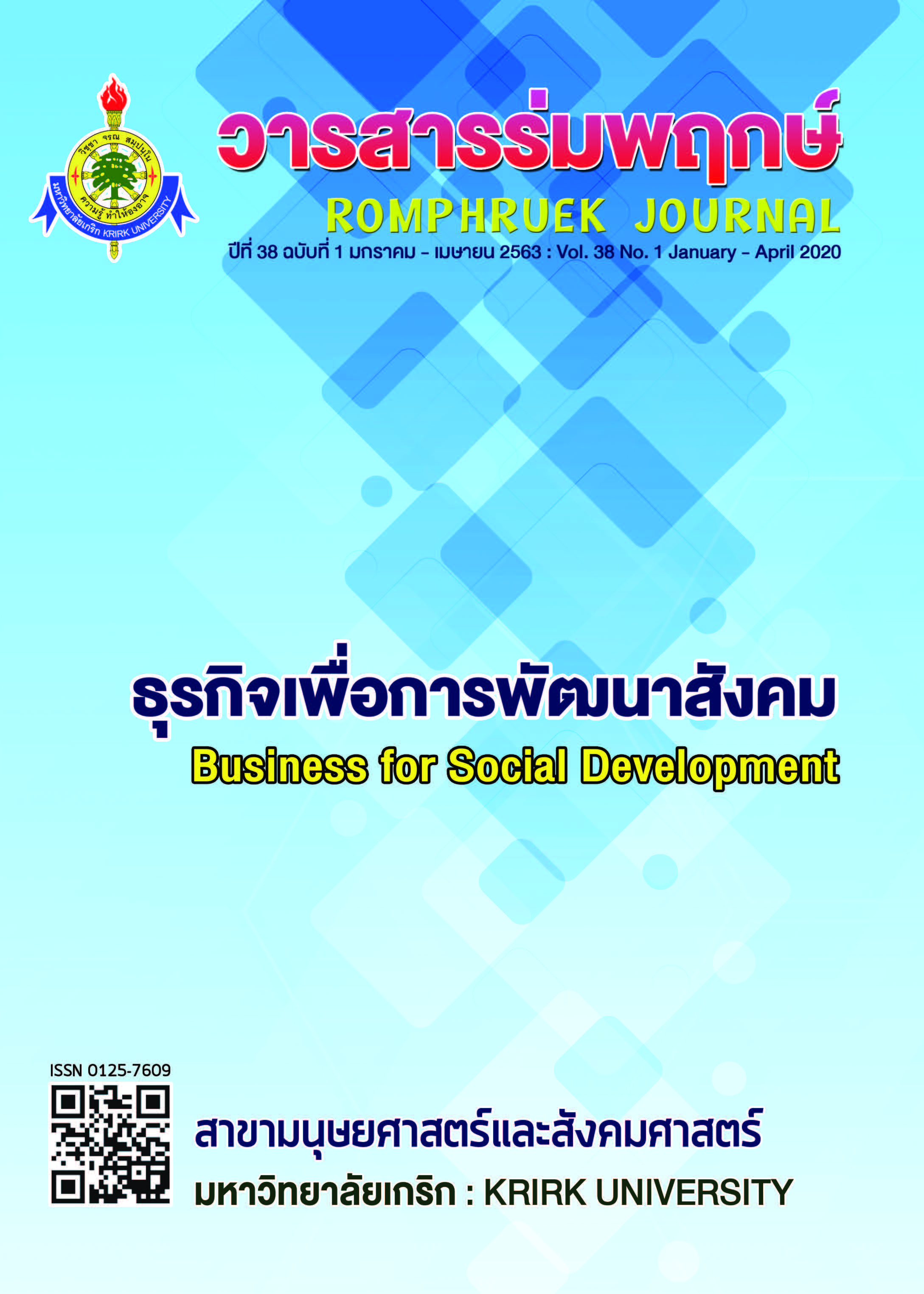Conditions And Guidelineds For Community Based Tourism Development A Case Study Of Ban Khlong Peng Moo 2 Bang Nang Li Subdistict Amphawa District Samut Songkhram Province
Main Article Content
Abstract
The purpose of this research is to study conditions and guidelineds for community based tourism development a case study of Ban Khlong Peng moo 2 Bang Nang Li subdistict Amphawa Which is a qualitative research using focus group discussions from community leaders Which is the main force in driving the community of the village of 10 people by purposive sampling. The research instrument is the researcher with questions for discussion. Voice recorder and camera The results of the research showed that Ban Khlong Peng, Village No. 2, Bang Nang Li Subdistrict, Amphawa District, Samut Songkhram Province Is a village that is ready to be a tourist attraction by the community There are community leaders and organization groups. That is strong People in the community have love, unity. Help each other Have a good social capital There are many cultures. There is a clear road infrastructure and signage. Convenient to travel And not far from the main tourist spots People in the community have the opportunity to access to funding sources. Ready to receive the development to become a tourist destination by the community.Able to carry out co-operation, co-operation, and co-creation by the people in the community. For the development approach to be a tourist attraction, the community has 6 steps which are 1) Studying the readiness and possibility of the community together with the people in the community 2) Team building and development network 3) Potential development planning Tourism and resource management layout 4) Try out tourism activities Develop and drive operations 5) Monitoring and evaluation 6) Planning and development Which these guidelines Will help bring people in the community to manage the tourism of the village by themselves
Article Details
Every article published in the Romphruek Journal of the Humanities and Social Sciences is the opinion and point of view of the authors. Thery're not the viewpoint of Krirk University or the editored department. Any part or all of the articles for pablication must be clearly cited.
References
กรมการพัฒนาชุมชน. (2562). ข้อมูลความจำเป็นพื้นฐาน (จปฐ.) และข้อมูลพื้นฐานระดับหมู่บ้าน (กชช2ค).
(22 กรกฎาคม 2562) สืบค้นจาก https://ebmn.cdd.go.th.
กระทรวงการท่องเที่ยวและกีฬา. (2562). ระบบสถิติท่องเที่ยวของประเทศไทย กระทรวงการท่องเที่ยวและ
กีฬาระบบสถิติท่องเที่ยวของประเทศไทย. (20 กรกฎาคม 2562) สืบค้นจาก
https://www.mots. go.th/more_news_new.php?cid=497.
ณัฎฐพัชร มณีโรจน์. (2560). การจัดการท่องเที่ยวโดยชุมชน. (28 กรกฎาคม 2562) สืบค้นจาก
https://www.tci-thaijo.org/index.php/jitt/article/view/113060.
พจนา สวนศรี. (2546). คู่มือการจัดการท่องเที่ยวโดยชุมชน. กรุงเทพมหานคร : โครงการท่องเที่ยวเพื่อชีวิตและธรรมชาติ.
พจนา สวนศรี และ สมภพ ยี่จอหอ. (2556). คู่มือมาตรฐานการท่องเที่ยวโดยชุมชน.
เชียงใหม่ : หจก.วนิดาการพิมพ์.
วีระพล ทองมา. (2559). การท่องเที่ยวโดยชุมชน (Community Based Tourism : CBT) สำหรับการพัฒนา
คุณภาพชีวิตของชุมชนในเขตที่ดินป่าไม้. (20 กรกฎาคม 2562) สืบค้นจาก
https://www.dnp.go.th/fca16/file/i49xy4ghqzsh3j1.doc.
สำนักงานพัฒนาชุมชนจังหวัดนครพนม. (2562). ท่องเที่ยวโดยชุมชน จังหวัดนครพนม. (22 กรกฎาคม 2562)
สืบค้นจาก https://nakhonphanom.cdd.go.th.
อัจฉรา ศรีลาชัย และ ภูเกริก บัวสอน. (2561). แนวทางการจัดการรูปแบบการท่องเที่ยวโดยชุมชนอย่าง
ยั่งยืนกรณีศึกษาชุมชนบ้านโคกเมือง ตำบลจรเข้มาก อำเภอประโคนชัย จังหวัดบุรีรัมย์.
บัณฑิตศึกษามหาวิทยาลัยราชภัฏวไลยอลงกรณ์ ในพระบรมราชูปถัมภ์, กรุงเทพมหานคร.
องค์การบริหารการพัฒนาพื้นที่พิเศษเพื่อการท่องเที่ยวอย่างยั่งยืน (องค์การมหาชน). (2562). การท่องเที่ยวอย่างยั่งยืน.
(2 พฤษภาคม 2562). สืบค้นจากhttps://www.dasta.or.th/th/medias.
Bello, F. G., Lovelock, B., & Carr, N. (2016). Enhancing community participation in tourism
planning associated with protected areas in developing countries : Lessons from
Malawi.Tourism and Hospitality Research. Journal and hospitality Research, 3(5), 407-423.
Dickman, S. (1996). Tourism : An Introductory Text, 2nd ed., Australia : Hodder Education.
Lee, T. H. (2013). Influence analysis of community resident support for sustainable tourism
development. Tourism Management, 34, 37-46.


